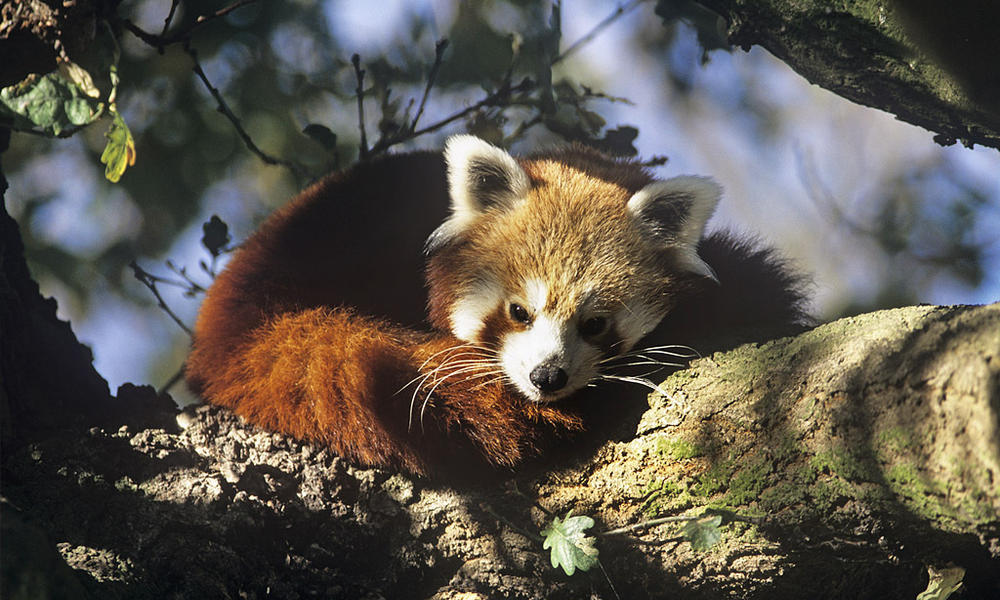THE RED PANDA
The red panda (Ailurus fulgens), also called the lesser panda, the red bear-cat, and the red cat-bear, is a mammal native to the eastern Himalayas and southwestern China. It has reddish-brown fur, a long shaggy tail, and a waddling gait due to its shorter front legs; it is roughly the size of a domestic cat, though with a longer body and somewhat heavier. It is arboreal, feeds mainly on bamboo, but also eats eggs, birds, and insects. It is a solitary animal, mainly active from dusk to dawn (nocturnal), and is largely sedentary (inactive) during the day.
The red panda has been classified as Endangered by the IUCN (International Union for Conservation of Nature) because its wild population is estimated at less than 10,000 mature individuals and continues to decline due to habitat loss and fragmentation, poaching (illegally hunt), and inbreeding depression, although red pandas are protected by national laws in their range countries.
Animalia
| |
Chordata
| |
Mammalia
| |
Carnivora
| |
Ailuridae
| |
Ailurus
| |
Ailurus fulgens
| |
Red Panda
| |
Other Name(s):
|
Lesser Panda, Fire Fox
|
The red panda is the only living species of the genus Ailurus and the family Ailuridae. It has been previously placed in the raccoon and bear families, but the results of phylogenetic analysis provide strong support for its taxonomic classification in its own family, Ailuridae, which is part of the superfamily Musteloidea along with the weasel, raccoon and skunk families.
The head and body length of a red panda measures 50 to 64 cm (20 to 25 in), and its tail is 28 to 59 cm (11 to 23 in). Males weigh 3.7 to 6.2 kg (8.2 to 13.7 lb) and females 3 to 6.0 kg (6.6 to 13.2 lb). They have long, soft, reddish-brown fur on the upper parts, blackish fur on the lower parts, and a light face with tear markings and robust cranio dental features. The light face has white badges similar to those of a raccoon, but each individual can have distinctive markings. Their roundish heads have medium-sized upright ears, black noses, and blackish eyes. Their long, bushy tails with six alternating transverse ochre rings provide balance and excellent camouflage against their habitat of moss- and lichen-covered trees. The legs are black and short with thick fur on the soles of the paws. This fur serves as thermal insulation on snow-covered or icy surfaces and conceals scent glands, which are also present on the anus.
The red panda is specialized as a bamboo feeder with strong, curved and sharp semi-retractile claws standing inward for grasping narrow tree branches, leaves, and fruit. Like the giant panda, it has a “false thumb” which is an extension of the wrist bone. When descending a tree head-first, the red panda rotates its ankle to control its descent, one of the few climbing species to do so.
They are shy and solitary except when mating. Females give birth in the spring and summer, typically to one to four young. Young red pandas remain in their nests for about 90 days, during which time their mother cares for them. (Males take little or no interest in their offspring.)
The life cycle of a red panda starts as a cub. A mother can have one to four cubs at a time, but usually has twins. A cub is usually born around the summertime or the springtime, after around 130 after mating. At first, the mother makes a nest from leaves and plants on a rock or in a hollow tree. When the mother gives birth to her young, the cubs at first are blind after 3 weeks. A cub is weaned from three to four months. In order to provide milk for her cubs, she has to eat 3 times the amount of bamboo she usually eats. A cub stays at their nest for about ninety days, until they go out and learn how to survive in the enviroment. Then after around a year, the cubs are finally fully grown into adults and now live independantly. The average life span for a red panda is up to 13 years.
https://ashleycp6.weebly.com/life-cycle.html
https://a-z-animals.com/animals/red-panda/
What is the kingdom of red panda?
Where do red pandas commonly found?
How long is the length of most red pandas tail?
When does the mother make a nest?
https://a-z-animals.com/animals/red-panda/
What is the kingdom of red panda?
Where do red pandas commonly found?
How long is the length of most red pandas tail?
When does the mother make a nest?

Komentar
Posting Komentar